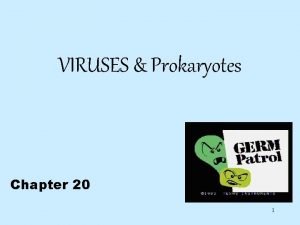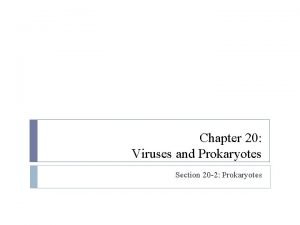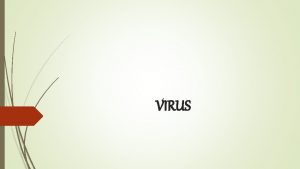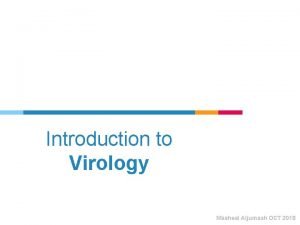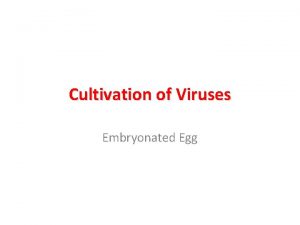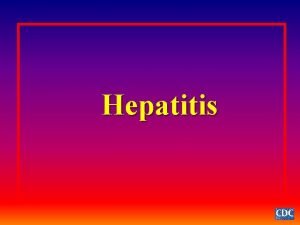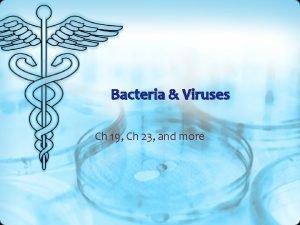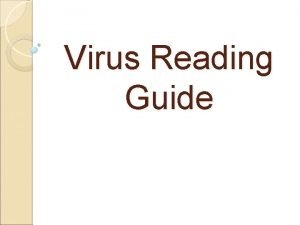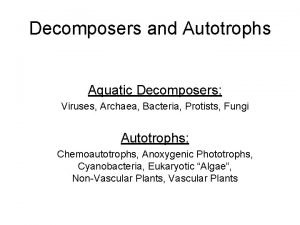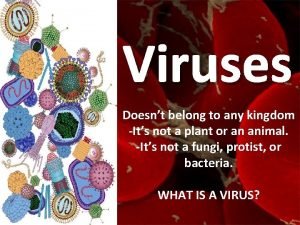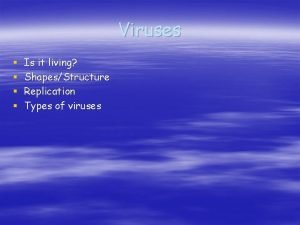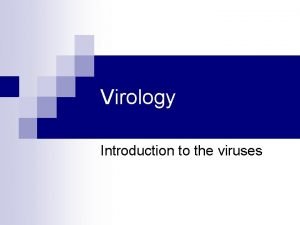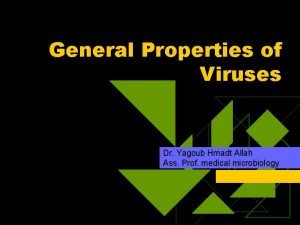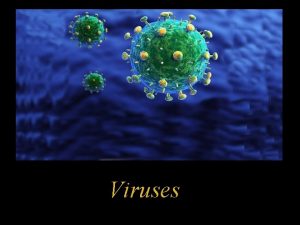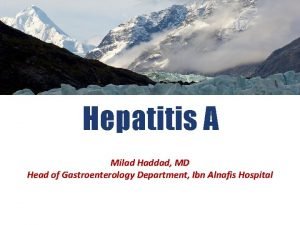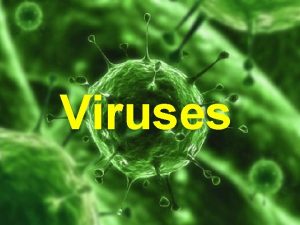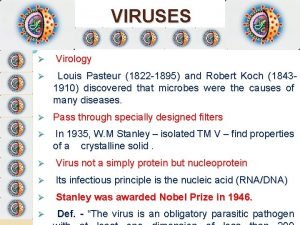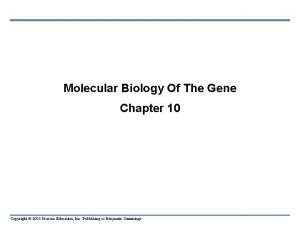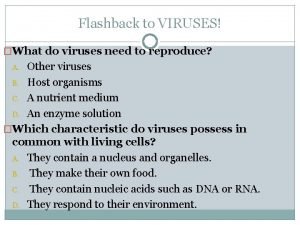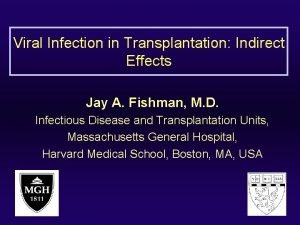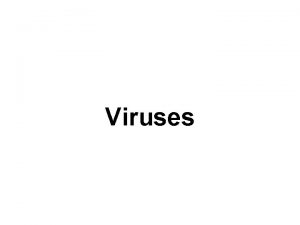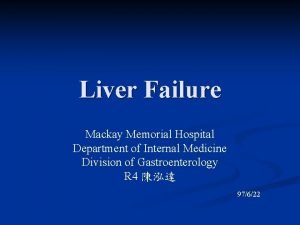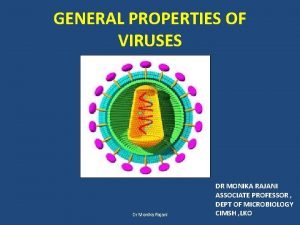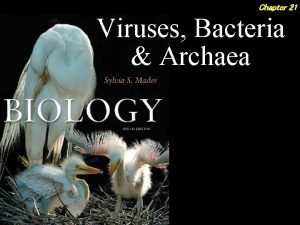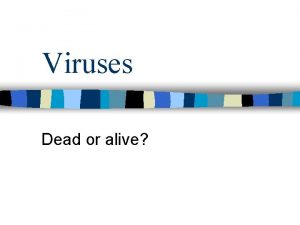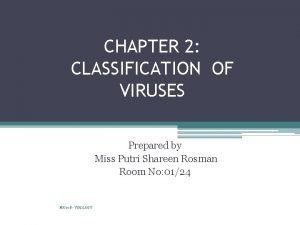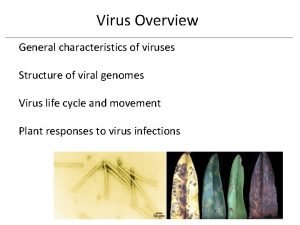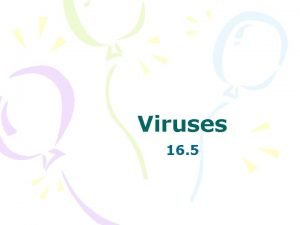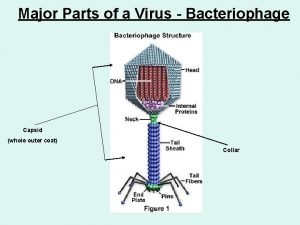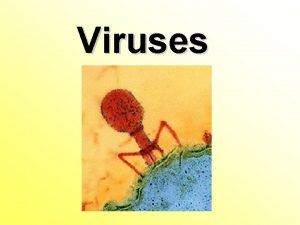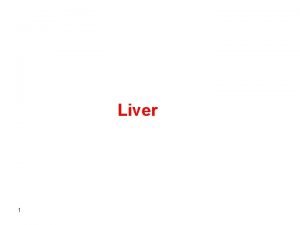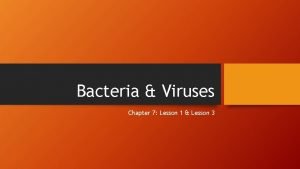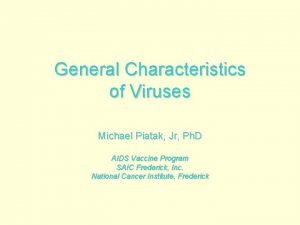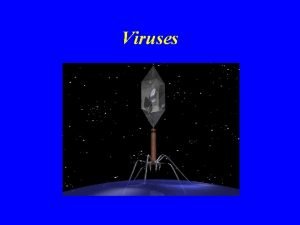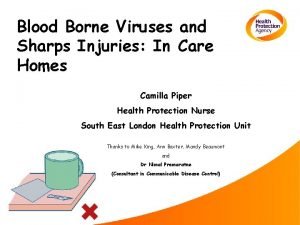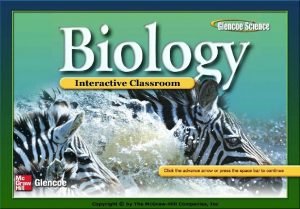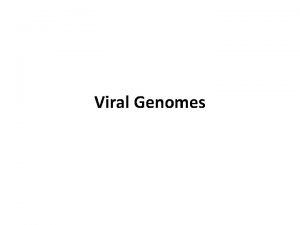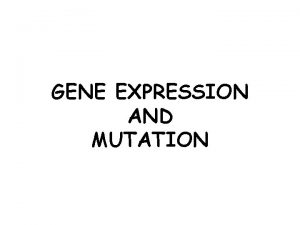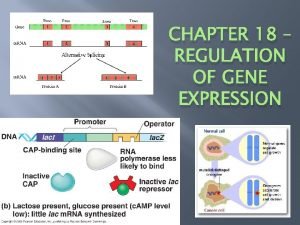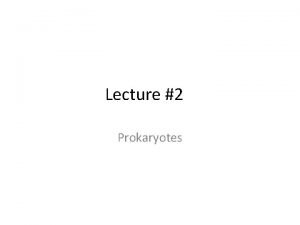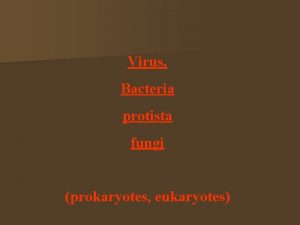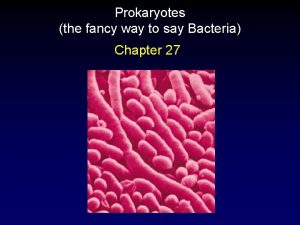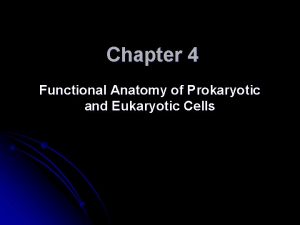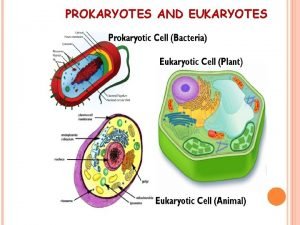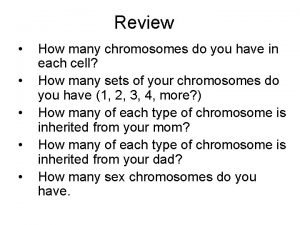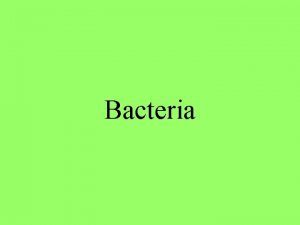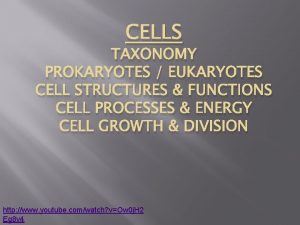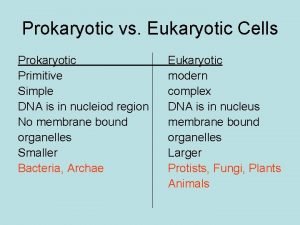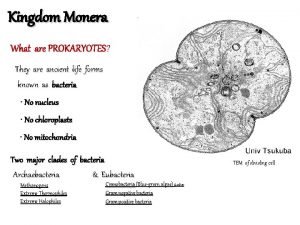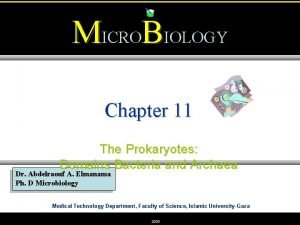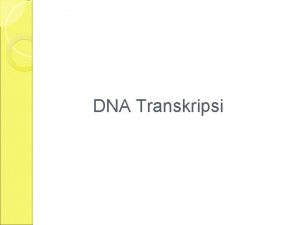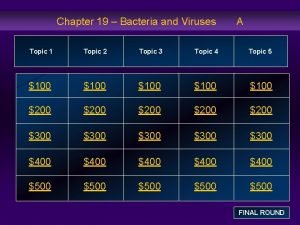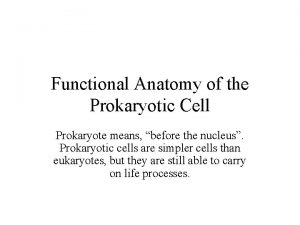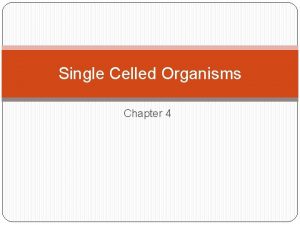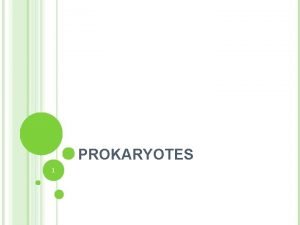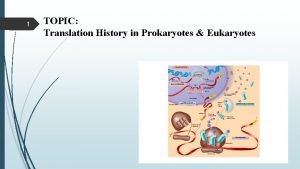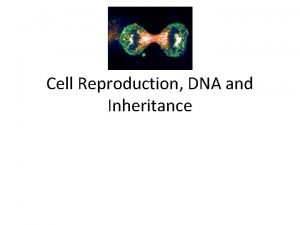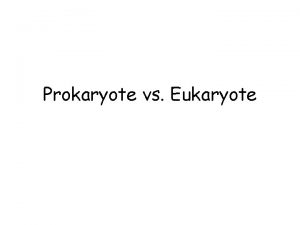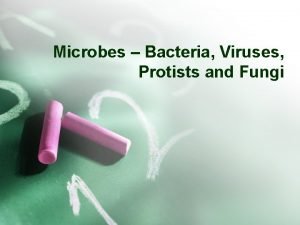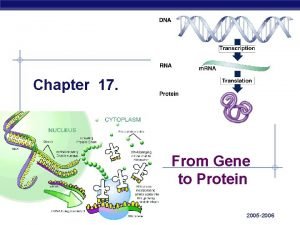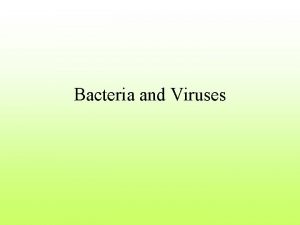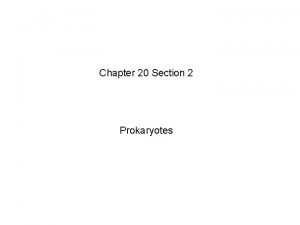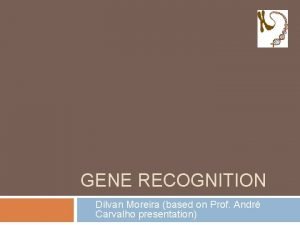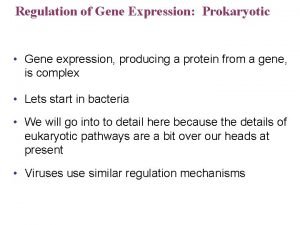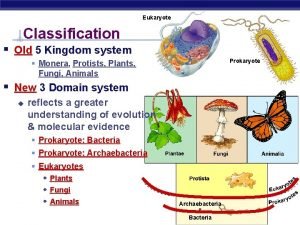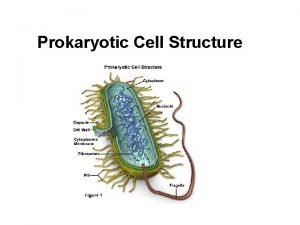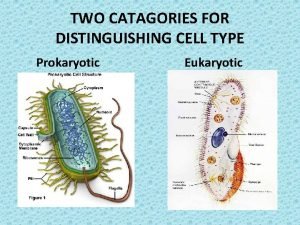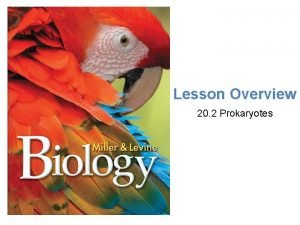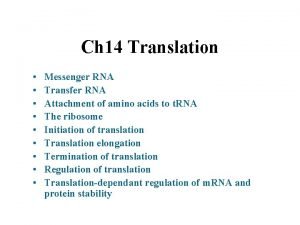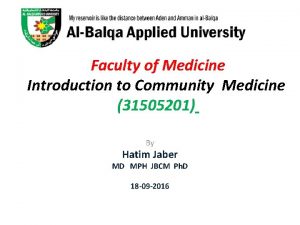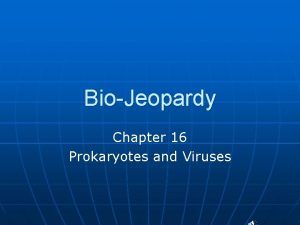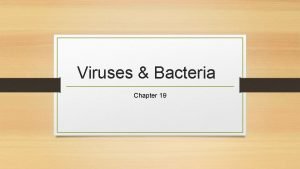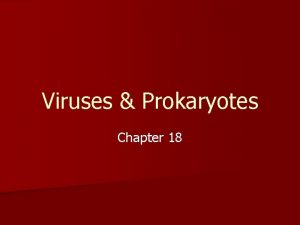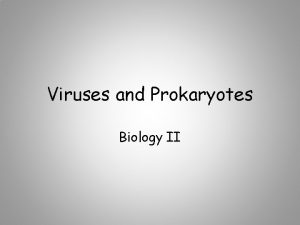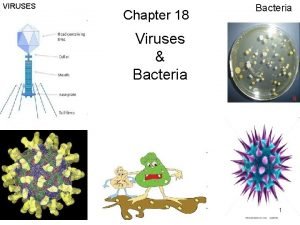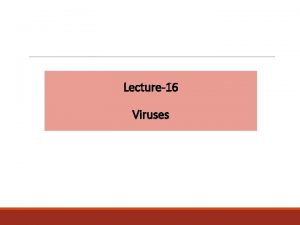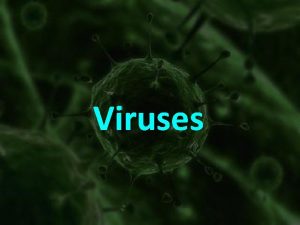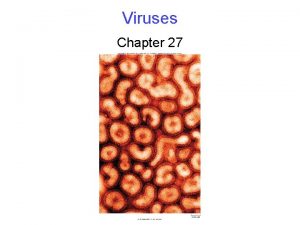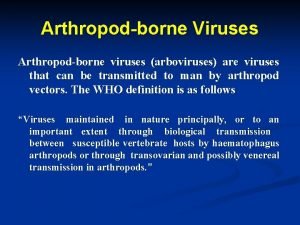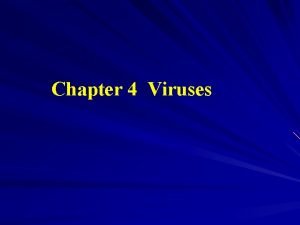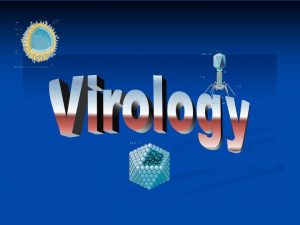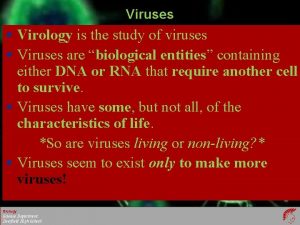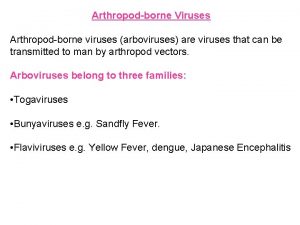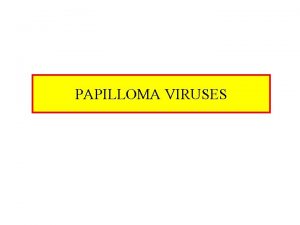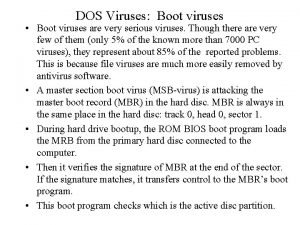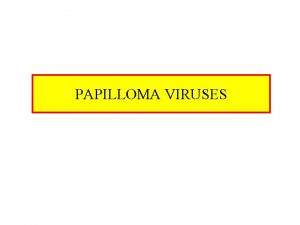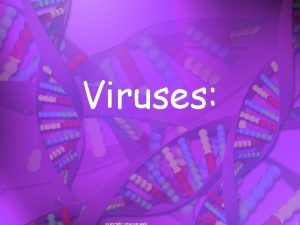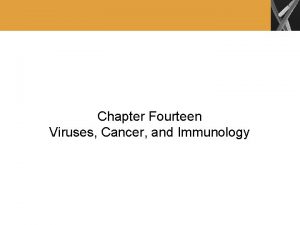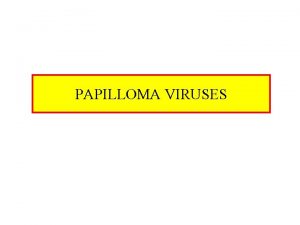Ch 18 Viruses Prokaryotes Main Concepts 1 2













































![Several Types of Archaebacteria Exist 2. Halophiles: live in environments of high [salt], e. Several Types of Archaebacteria Exist 2. Halophiles: live in environments of high [salt], e.](https://slidetodoc.com/presentation_image/ee123551fe2d23eac1a41ecc8d01f2a9/image-46.jpg)


























































- Slides: 104

Ch. 18: Viruses & Prokaryotes

Main Concepts: 1. 2. 3. 4. 5. 6. 7. Prokaryotes lack nuclei and membraneenclosed organelles. Bacteria occupy every imaginable niche. Archaebacteria may be the most ancient of all organisms. Although some prokaryotes cause disease, the vast majority are beneficial and essential. Some diseases caused by bacteria and viruses are transmitted mainly by sexual contact. Viruses have profound effects on organisms. AIDS, caused by HIV, is a worldwide human health problem.

18. 1: Studying Viruses and Prokaryotes Virus: an infectious agent that contains a nucleic acid (either DNA or RNA) and a protein coat (capsid). Pathogen: any disease-causing agent, e. g. a virus, a bacteria, etc. Viroid: an infectious particle that causes disease in plants. Prion: an infectious particle consisting of only a protein that can cause other proteins to fold incorrectly. n Contains no genetic material

18. 2: Viral Structure & Reproduction p p p Many diseases are caused by viruses: AIDS, hepatitis, measles, mumps, influenza, colds, polio. Small enough to pass through biological filters; can only be seen with electron microscope. Bacteriophage (AKA phage): virus that preys on bacteria (Fig. 18. 5, p. 549)

18. 2: Viral Structure & Reproduction

18. 2: Viral Structure & Reproduction

18. 2: Viral Structure & Reproduction p Upon entering a cell, a virus may: 1. 2. p Act as an agent of disease, disrupting normal cell functioning and sometimes killing cell. Act as an agent of heredity, causing permanent inheritable changes. Differ from living things in several ways: n n n Can only reproduce copies of themselves inside a living organism. Have no metabolism of their own. Do not have cell parts.

18. 2: Viral Structure & Reproduction p Viruses (viroids) can infect plants and bacteria as well as animals.

Viral Infection Lytic Infection: p (Fig. 18. 6, p. 550)

Viral Infection Lysogenic Infection: p p (p. 550) Prophage: the phage DNA inserted into and combined with the host cell’s DNA

18. 3: Viral Diseases p p Some viruses store genetic material as DNA; others as RNA. Some of the latter group are known as retroviruses.

18. 3: Viral Diseases p Retroviruses go through an extra step before they can reproduce; they make copies of DNA from RNA (reverse of normal flow of genetic information). n n n The retrovirus binds to the surface of a host cell (like other viruses), and injects its RNA into the cell (p. 553). Reverse transcriptase, an enzyme associated with RNA, facilitates the formation of a complementary DNA strand, which can then be integrated into the host cell’s DNA, replicated, and transmitted to offspring cells. When the cell produces RNA from its own DNA, it also produces viral RNA, which becomes the source of new viral particles, thus continuing the infection.

18. 3: Viral Diseases p p p Retroviruses cause cancer in some animals and have been associated with certain types of cancer in humans. Human oncogenes are in some ways similar to the genes in retroviruses; both cancerous growth if disturbed. AIDS: caused by a retrovirus which attacks and kills certain cells of the immune system.

31. 6 HIV & AIDS p p p AIDS (Acquired Immune Deficiency Syndrome) Syndrome: a group of conditions that occur together. First identified in 1983.

31. 6 HIV & AIDS p Caused by HIV (Human Immunodeficiency Virus), which primarily infects helper T cells of immune system; also affects brain and nerve cells, all of which have a CD 4 molecule on their cell-surfaces where the virus attaches.

31. 6 HIV & AIDS

HIV: a Retrovirus

31. 6 HIV & AIDS

31. 6 HIV & AIDS p p Inside host cell, the viral RNA is copied into DNA (HIV is a retrovirus). The DNA may then be incorporated into the genome of the host and replicated as the cell divides. Eventually, the cell ruptures and releases hundreds of viruses, each of which can infect other cells.

31. 6 HIV & AIDS p p Reproduction of HIV in helper T cells eventually gradual decline in number of T cells and a weakened immune system. This increases the susceptibility of the individual to opportunistic infections and cancers. It is these opportunistic diseases that account for 90% of deaths from AIDS. Incubation period: 2 wks. – 3 mos. An infected individual may not develop AIDS for months, or even years.

31. 6 HIV & AIDS p Symptoms: varied; Pneumocystis pneumonia, Kaposi’s sarcoma (a skin cancer), thrush (candidiasis), dementia, fungal, protozoan and eubacterial infections like tuberculosis, et al. Kaposi’s Sarcoma Oral Thrush

31. 6 HIV & AIDS Periods of illness may alternate with periods of relative good health. p Diagnosis is based on presence of certain infections or cancers (as listed above) in a person who tests positive for HIV antibodies. p Once diagnosed with full-blown AIDS, one may live from 5 – 20 yrs. p Test is for antibodies to the virus p

31. 6 HIV & AIDS p Test is for antibodies to the virus.

31. 6 HIV & AIDS Means of infection: p Sexual contact (blood to blood), contact with contaminated blood by sharing of needles, etc. p Receiving infected blood from a blood transfusion used to be a more serious concern until medical profession began screening blood bank more carefully (~ 1985). p Some health care professionals have become infected by way of cuts on their skin, or accidents with used needles. p From mother to embryo or child: n n n HIV can cross placental barrier. In birthing process. In mother’s milk.

31. 6 HIV & AIDS p No evidence that HIV is transmitted by casual contact, e. g. shaking hands, using the same swimming pool.

18. 3: Viral Diseases p p p Vaccines: substances containing antigens which stimulate the production of antibodies in order to ward off disease prior to infection. Antigen: protein marker on surface of invading cell or virus that allows body to identify it as a “foreign attacker. ” Vaccines contain only enough of the killed or weakened disease -causing agent to bring about the production of antibodies without producing the symptoms of the disease.

18. 3: Viral Diseases Antibodies: proteins produced by the body that help protect the body against pathogens p Memory cells keep later infections by the same pathogen from causing disease.

18. 3: Viral Diseases p Edward Jenner (1796): first to use vaccines to protect people from smallpox.

31. 6 HIV & AIDS p Prospects for a vaccine are improving, though no one has suggested a concrete timeframe for the availability of one. n p Studies of pregnant women who are infected and their babies suggest that antibodies may be effective in protecting against the disease. Research is ongoing to design specific drugs that block the action of the HIV virus: n n n Introduce CD 4 molecules attached to viral toxins as “decoy” attachment sites for virus. Cytokines: turn off the production of HIV in lab studies, and, thus, delay the onset of the disease Unfortunately, all these drugs have serious side effects.

31. 6 HIV & AIDS p Combination drug therapy, AKA drug “cocktails”: n n n p Proving to be most effective therapy to date. Inhibitor: prevents enzyme, reverse transcriptase, from copying DNA from RNA. Nucleotide analogue: ineffective “mimic” nucleotide that would disrupt viral DNA or RNA sequence. Other drugs, e. g. AZT, that inhibit the virus’ ability to replicate. In concert, these drugs may block many different steps in viral infection. May be a new treatment for Kaposi’s sarcoma that blocks the action of tumor growth factors.

31. 6 HIV & AIDS p Therapy taking advantage of evolution of virus (as in “Darwin” film): n n n After virus has “adapted” to/become resistant to drugs, stop drug therapy for a time. Allows virus to revert back to “wild type” which is susceptible to drugs. Resume drug therapy after a time in hopes of killing virus before it can evolve resistance once again.

18. 4 Prokaryotic Structure p p p Small; most = microscopic, but range from 0. 3 – 0. 7 µm (Rickettsia) to 500 µm (a bacteria found in the gut of the Red Sea surgeonfish). > 20, 000 spp. have been described, but most have not yet been identified. Shapes: 1. 2. 3. 4. 5. n Rod Sphere Spiral Filament Short, curved rod Fig. 18. 12, p. 556 Spirochetes

18. 4 Prokaryotic Structure p p p Some form multicellular structures of colonies or chains. Many move by means of flagella; others by gliding over surfaces. Some can cause sickness, or even death (e. g. Rocky Mountain spotted fever) Most have rigid cell walls containing lipids, carbohydrates and protein (but no cellulose). Inside the cell wall is a cell membrane.

18. 4 Prokaryotic Structure p Fig. 18. 13, p. 557

18. 4 Prokaryotic Structure p Mesosome: an infolding of the cell membrane that may play roles in: n Secretion: p n p Movement of particles out of bacterial cell, and/or Copying chromosome before cell division. Prokaryotes have one main chromosome (the nucleoid). n n n No homologous pairs. No genes in pairs. Attached to cell membrane.

18. 4 Prokaryotic Structure p Usually also contain one or more smaller, circular DNA molecule, a plasmid. n n Consist of only a few genes, they confer important abilities on the bacterial cells, e. g. antibiotic resistance. Important in genetic engineering and gene cloning.

18. 4 Bacteria – Not all bad! 1. Bioremediation: Bacteria are able to digest almost anything, including cellulose and petroleum. n 2. Essential in all food webs as decomposers. n n 3. 4. 5. Some have been used in oil spill clean-ups. Break down organic matter into inorganic nutrients. Some do opposite and transform inorganic materials into complex organic compounds. Serve as food for protists and other microorganisms. Many are photosynthetic. Some are the source of antibiotics. Thus, they serve many important functions

18. 4 Prokaryotes p p All reproduce asexually (binary fission). A form of genetic exchange (conjugation) may occur, in which one prokaryote transfers a portion of its DNA through a tube to another. The genetic contributions of parents, though, are not equal. Not true reproduction Viruses can also transfer genetic material between prokaryotes.

18. 4 Classification of Prokaryotes p Two fundamentally different groups: n n K: Archaebacteria (D: Archaea) K: Eubacteria (D: Bacteria)

Archaebacteria p p Archaebacteria: “ancient” bacteria; oldest organisms on Earth? ? ? Biochemistry and adaptation to extreme environments suggest they were among the earliest life forms on earth.

18. 4 Archaebacteria p Prokaryotic fossils date to 3. 5 BYA; probably the first living organisms. n p p Found in stromatolites ~ 2. 5 – 2 BYA some photosynthetic prokaryotes brought about a change in the atmospheric composition, increasing the [O 2] to 1% (Plants increased it further to 20%): the “Oxygen Revolution. ” These changes made it possible for multicellular life to evolve.

18. 4 Archaebacteria p Some prokaryotes can tolerate extreme environmental conditions, e. g. low temps (even freezing), boiling waters of hot springs, hot acids, high pressure at ocean depths, and low pressure in upper atmosphere. n p p By forming endospores, complex thick-walled structures containing DNA, they can tolerate nutrient limitations. Are among the first organisms to invade a new environment, as after volcano or fire. Help transform such environments, creating more hospitable conditions for other life to take up residence there.

Archaebacteria p Different from all other forms of life. 1. 2. 3. 4. Cell walls lack peptidoglycan (present in cell walls of eubacteria) Plasma membranes of archaebacteria are different from those of eubacteria and eukaryotes (contains lipids that are unique to this group). Archaebacterial ribosomes are unique in shape. RNA nucleotide sequence is different from that of eubacteria. p Using such sequencing can illustrate the degree of relatedness among organisms.

18. 4: Aerobes and Anaerobes Obligate anaerobes: poisoned by oxygen n e. g. methanogens Obligate aerobes: require oxygen n Includes many pathogens, e. g. those that cause tuberculosis and leprosy Facultative aerobes: can survive with or without oxygen

Several Types of Archaebacteria Exist 1. Thermoacidophiles: live in hot, acidic environments: water temps of 70 - 90 C; p. H of 2 or less, e. g. sulfer hot springs, coal-mining debris piles; despite the low p. H of their environment, thermoacidophiles maintain an internal p. H close to neutral (7). n n Convert above Celsius values to Fahrenheit (˚F = 9/5˚C + 32). 158 – 194 ˚F
![Several Types of Archaebacteria Exist 2 Halophiles live in environments of high salt e Several Types of Archaebacteria Exist 2. Halophiles: live in environments of high [salt], e.](https://slidetodoc.com/presentation_image/ee123551fe2d23eac1a41ecc8d01f2a9/image-46.jpg)
Several Types of Archaebacteria Exist 2. Halophiles: live in environments of high [salt], e. g. salt brine; ocean borders; salty inland water, e. g. Great Salt Lake, Dead Sea; some are photosynthetic but do not contain chlorophyll; use rhodopsin instead; may cause salted fish to become discolored and spoiled.

Several Types of Archaebacteria Exist 3. Methanogens: produce methane (CH 4) as a metabolic byproduct from H 2 and CO 2 n n n Live only in anaerobic conditions, e. g. stagnant water, sewage treatment plants, ocean bottoms, and hot springs Commonly found with eubacteria that decompose organic matter and release hydrogen gas Play role in carbon cycle: remove organic compounds from sediments and release CH 4 to atmosphere, where it reacts with O 2 to form water and CO 2, thus contributing to level of CO 2 in atmosphere.

Several Types of Archaebacteria Exist Digestion of Cellulose by Methanogens in Ruminants: p Rumen: First of four chambers (stomachs) of the digestive tract of cows, goats, sheep, deer and antelope in which protozoans, eubacteria and archaebacteria (methanogens) live. p Protozoa and eubacteria: contain enzymes that break down cellulose from grass or plant material. p Methanogens: use the CO 2 and hydrogen as food and produce methane gas.

Several Types of Archaebacteria Exist p p Methane can be used as a fuel. Methanogens may be used in garbage, sewage, agricultural waste and manure to produce methane from these sources. Methane produced this way could be used to heat homes. Could help two problems: n n Waste and garbage buildup. Energy crisis.

Eubacteria p Classification of eubacteria is still unclear due to great diversity within the group: n n Aerobic and anaerobic Autotrophic and heterotrophic p n n Photosynthetic and chemosynthetic Thermophilic and psychrophilic Metabolically diverse

Eubacteria 1. Mycoplasmas: probably the smallest (0. 2 – 0. 3 µm) organisms capable of independent growth p p Lack a rigid cell wall Possess a triple-layered membrane of lipids Extremely simple cell structure Resistant to penicillin p Therefore, of special evolutionary interest; most are harmless; some cause disease, e. g. pneumonia.

Eubacteria 2. Gram Positive (Fig. 18. 14, p. 557): n n Possess thick peptidoglycan (a sugar-amino acid polymer) wall with no outer lipoprotein layer Stain purple with Gram’s stain Gram-positive Bacillus anthracis bacteria (purple rods) in cerebrospinal fluid sample. The other cells are white blood cells.

Eubacteria 2. Gram Positive: n n Widespread in soil and air Some produce lactic acid and are used to prepare sauerkraut, buttermilk Some are sources of antibiotics, e. g. streptomycin, tetracycline and erythromycin Some form endospores to survive unfavorable growth conditions.

Eubacteria 3. Gram Negative: n n n Thin peptidoglycan wall with outer lipoprotein layer Stain pink with Gram stain Wide variety of metabolic styles

Eubacteria 3. Gram Negative: n Many anaerobic photosynthetic forms which don’t use water and do not produce oxygen p p n Use green and purple pigments Many use hydrogen sulfide and produce sulfur Others use hydrogen gas or lactic acid Synthesize organic compounds from CO 2 and convert light energy to chemical energy. Most pathogenic bacteria (for humans) are gram negative.

Eubacteria

Eubacteria 4. Cyanobacteria: (blue-green eubacteria) n n Photosynthetic Wide variety of environments, e. g. hot springs, under ice of Antarctic lakes Responsible for algal blooms on freshwater lakes and streams that have been polluted with phosphates Some grow in colonies visible with naked eye

Eubacteria 4. Cyanobacteria: (blue-green eubacteria) n n Contain chlorophyll in cell membranes, but no chloroplasts in those membranes Use water in photosynthesis and release oxygen Thought to be responsible for “oxygen revolution” Remains found in stromatolites.

Eubacteria p p Cyanobacteria make their own food from energy from the sun and carbon from CO 2. Other eubacteria get food from other organisms, either living or dead: a. b. If food source is living, bacteria are called “parasites. ” If dead, “decomposers. ”

Eubacteria 5. Chemoautotroph's (chemosynthetic): eubacteria that obtain energy from inorganic molecules in environment.

Eubacteria and the Nitrogen Cycle p Both chemosynthetic and decomposer eubacteria play important roles in nitrogen cycle: n n n Nitrogen is important for life; part of proteins and nucleic acids. N cycles from biotic to abiotic parts of ecosystem (see Fig. 11. 14, p. 287). N 2 gas in atmosphere is unusable to plants and animals. Consumers get their N from nitrogen-containing compounds they eat, i. e. ultimately producers. Producers get their N from soil or water in which they grow. They require nitrogen-fixing eubacteria (some chemosynthetic; some photosynthetic).

Eubacteria and the Nitrogen Cycle

Nitrogen Cycle Nitrogen fixers: 1. Nitrogen fixers convert N 2 gas (inorganic form) to ammonia (NH 3; NH 4+ = organic form), which can be used to synthesize proteins and other nitrogen-containing compounds.

Nitrogen Cycle Nitrogen fixers: n n n Members of legume (pea) family are important nitrogenfixers, e. g. clover, peas, beans, alfalfa. The plants are not the nitrogen-fixers though; eubacteria living in their roots are (symbiotic relationship). These eubacteria cause the plants’ roots to form swellings called nodules (see Fig. 11. 15, p. 287), e. g. Rhizobium meliloti.

Nitrogen Cycle Nitrogen fixers: 1. Some free-living eubacteria and cyanobacteria can also fix nitrogen. n The ammonia fixed by the eubacteria can be used by the bacteria themselves, the legume plants, or by other plants.

Eubacteria and the Nitrogen Cycle

Nitrogen Cycle 2. Two groups of nitrifying eubacteria continue the nitrogen cycle: 1. 2. p One group: ammonium ions (NH 4+) to nitrite ions (NO 2 -), e. g. Nitrosomonas. Second group: nitrite ions to nitrate ions (NO 3 -), e. g. Nitrobacter winogradskyi. Plants can absorb nitrates from the soil and use them to build proteins.

Eubacteria and the Nitrogen Cycle

Nitrogen Cycle n n 3. Nitrifying eubacteria live only under aerobic conditions. Oxygen from the air spaces found between soil particles dissolves in soil water. When these spaces fill with water and create anaerobic conditions, denitrifying eubacteria operate to change any remaining nitrates (NO 3 -) to nitrogen gas (N 2), which escapes into the atmosphere, completing the cycle.

Nitrogen Cycle 4. Decomposer eubacteria in the soil break down the complex organic compounds in dead plants and animals. n n n They use the energy in these compounds and convert the compounds to simpler substances, including the gas, ammonia. Some of the ammonia escapes into the atmosphere; but much dissolves in soil water and reacts with hydrogen ions (H+) to form ammonium ions (NH 4+). In this form, nitrogen may be absorbed by the roots of plants and built into living material again by the plants.

Nitrogen Cycle (summary) 1. 2. 3. 4. Nitrogen fixing: conversion of atmospheric nitrogen (N 2) to ammonia (NH 3), then to ammonium (NH 4+) by nitrogen fixing bacteria. Nitrification: aerobic environment; inorganic organic; conversion of ammonium nitrate (NO 3 -)by nitrifying bacteria. Denitrification: anaerobic environment; organic inorganic; nitrate gaseous compounds, e. g. nitrogen gas (N 2), nitric oxide (NO), nitrous oxide (N 2 O) by microorganisms (denitrifying bacteria). Decomposion: breaks down dead organic matter; decomposing bacteria convert organic nitrogen from dead organisms to ammonium.

Diseases p Causes of disease: n n n n n Viruses: AIDS, herpes. Eubacteria: Rocky Mountain spotted fever. Fungi: Athlete’s foot; ringworm; potato blight; corn smut. Protists: malaria; African sleeping sickness; amoebic dysentery. Worms: tapeworms (taenia) cysticercosis (worm larvae infect various organs). Insects: West Nile Fever; malaria. Diet deficiency: scurvy (lack of vitamin C). Advancing age: various cancers. Environmental pollutants: asthma. Heredity: Huntington disease, cystic fibrosis.

Causes of Disease

18. 6 Bacterial Diseases p p Disease: a condition that interferes with an organism’s ability to perform a vital function. Pathogen: the disease-causing agent, e. g. a bacteria or virus. . . n p . . . though an entire group may be infected by a pathogen, only certain individuals manifest symptoms of the disease. Therefore, it could be argued that the cause of the disease is not the pathogen alone, but an interaction between the pathogen and the organism affected; it could be argued that the cause of the disease is the infected organism’s lack of resistance. Host: the organism infected by the pathogen; if the pathogen harms the host, symptoms of disease may appear.

18. 6 Bacterial Diseases p p p p How serious a disease becomes depends on characteristics of both the pathogen and the host. Virulence: the ability of a pathogen to cause disease; its strength. Resistance: the infected host’s ability to cope with the pathogen. A pathogen with high virulence may cause death in a host with low resistance. A host with high resistance may only show mild symptoms. At times (when a host’s resistance is compromised) a mildly virulent pathogen may cause extended or serious illness, e. g. during a famine when proper nutrition is unavailable or when an individual doesn’t get adequate rest. Both genetics and resistance acquired during one’s lifetime can play a role in an organism’s ability to ward off disease.

31. 2: Immunity: resistance, whether acquired or inherited. p Passive Immunity: n n n Occurs without the body undergoing an immune response Passed from one generation to next via DNA Two types: p p Genetic Immunity: Immunity that a sp. has because the pathogen is not specialized to harm that sp. Inherited Immunity: Passed from mother to child either through umbilical cord or mother’s milk

31. 2: Immunity: resistance, whether acquired or inherited. p Active Immunity: n Immunity produced by one’s body in response to infection by a specific pathogen p Acquired Immunity: A type of active immunity; occurs after one’s immune system reacts to a pathogen invasion, e. g. one’s body produced antibodies in response to a vaccine.

31. 2: Immune Response Immune system: certain cells (e. g. white blood cells) and tissues (e. g. lymph glands) of the body that have a “chemical memory” for a particular pathogen once initially infected. If the same pathogen infects the host a second time, the immune system can respond more rapidly as a result, preventing symptoms from developing or being as severe.

31. 2: Immune Response Skin: p Provides a physical barrier that blocks pathogens from entering the body p Produces oil and sweat to make the skin hypertonic and acidic Mucous membranes: p Found in eyes, nose, ears, mouth, and excretory organs p Possess hairlike cilia covered with sticky liquid to trap pathogens and prevent their entry into the body

31. 2: Immune Response White blood cells: p Basophils & mast cells: Release chemical signals alerting the body to the invading pathogen p Eosinophils: Ward off parasites with toxins p Phagocytes: Cells that destroy pathogens by surrounding and engulfing them; attack viruses, bacteria & fungi n n Neutrophils: Engulf pathogens and foreign invaders Macrophages: Engulf dead or damaged body cells and some bacteria

31. 2: White blood cells

31. 2: Immune Response White blood cells (cont. ): p Lymphocytes: Initiate specific immune responses n n T-lymphocytes (T cells): Destroy body cells that are already infected with pathogens B-lymphocytes (B cells): Produce proteins (antibodies) that inactivate pathogens that have not yet infected a body cell

31. 2: Immune Response Proteins: Three types that fight off invading pathogens 1. Complement proteins 2. Antibodies 3. Interferons

31. 2: Immune Response Proteins: 1. Complement proteins: n n Made by WBC’s and other organs Work in one of three ways: 1. 2. 3. Weaken pathogen’s cell membrane, allowing water to enter and burst the cell Attract phagocytes to the area to kill the pathogen Cause microbial pathogens to stick to the walls of blood vessels where they can be more easily found and destroyed by phagocytes

31. 2: Immune Response Proteins: 2. Antibodies: p Made by B cells p Destroy pathogens in one of three ways: 1. 2. 3. Make pathogen ineffective by binding to its membrane proteins Cause pathogens to clump, making them easier for phagocytes to engulf and destroy Activate complement proteins that weaken the pathogen’s cell membrane

31. 2: Immune Response Proteins: 3. Interferon's: p Produced by body cells that are infected by a virus p Stimulate uninfected body cells to produce enzymes that will prevent viruses from entering and infecting them n p Virus then cannot reproduce Some interferons stimulate an inflammation response

18. 6 Bacterial Diseases As antibodies are specific to particular pathogens, they prevent recurrences of the same (or similar) diseases. p Some illnesses are caused by many different pathogens, however, e. g. common cold. Immunity to one type of cold-causing pathogen does not confer immunity to all the others. p

18. 6 Bacterial Diseases Antibiotics: chemicals that kill or slow the growth of bacteria

18. 6 Bacterial Diseases No archaebacteria are known to cause disease. Why? (Because of the extreme environments in which they live. No other organisms are there to be infected by them. ) p Some eubacteria do. p May be spread through water, food, or air. p Toxin: poisonous chemical produced by bacteria. p

18. 6 p Bacterial Diseases Most plants are susceptible to one or another eubacterial disease: n n Fire blight destroys fruit trees. Citrus canker is caused by at least 100 distinct varieties of the gram-negative eubacteria: Xanthomonas campestris.

18. 6 p Bacterial Diseases Many human diseases are also caused by eubacteria: Cholera, leprosy, tetanus, eubacterial pneumonia, whooping cough, diphtheria. n Many eubacteria live and multiply in the digestive tract, leaving the body in feces. If untreated feces enter water supply, other organisms may be infected by the pathogens when they drink the water.

18. 6 o Bacterial Diseases Waterborne diseases: typhoid o (caused by Salmonella)

18. 6 n Bacterial Diseases Food poisoning: most cases are caused by eubacteria; can cause diarrhea, nausea and vomiting within a few hours of infection. § Botulism (Clostridium botulinum) = extremely virulent; even a small amount may be fatal. § Staphylococcus aureus: most common form of food poisoning. § Salmonella: not strictly food poisoning, as organism must grow in the intestine before symptoms appear.

18. 6 p Bacterial Diseases Toxic shock syndrome: sudden drop in blood pressure, followed by fever, vomiting and diarrhea; caused by Staphylococcus aureus. n n n Most cases occur in menstruating women Tampons fibers absorb Mg, concentrating it. This enhances production of the toxins by the eubacteria.

18. 6 n Bacterial Diseases Airborne diseases: p p p Sneezing: droplets move at ~ 200 mph. Coughing: droplets move at ~ 100 mph. Eubacteria not killed by air may infect another person standing nearby.

18. 6 p Bacterial Diseases Dental disease/tooth decay: begins as a biofilm of dental plaque on surfaces of teeth and in crevices that have not been properly brushed/flossed.

18. 6 p p p Bacterial Diseases Eubacteria break down sugars to lactic acid which loss of calcium from the teeth. Enzymes released by eubacteria break down tooth enamel, allowing other eubacteria to penetrate teeth. Fluoride retards the loss of calcium from teeth and, thus, helps teeth resist decay.

34. 2 Sexually Transmitted Diseases p Eubacteria Cause Several Sexually Transmitted Diseases n n Gonorrhea, Syphilis, Chlamydia: caused by eubacteria AIDS, herpes: caused by viruses

34. 2 Sexually Transmitted Diseases Gonorrhea (Neisseria gonorrhea): p Can be killed by drying, sunlight, or UV light. p Transmitted by contact of moist membranes of the sex organs. p Symptoms: (in females) mild irritation of vagina; (in males) painful infection of urethra, burning during urination, discharge of pus. p Can cause eye infections in adults and in infants born to infected mothers. p Untreated, can sterility. p Treatment: antibiotics

34. 2 Sexually Transmitted Diseases Gonorrhea: p Number of cases increases each year because: 1. 2. 3. 4. Symptoms in females are mild; many don’t know they are infected and infect partners. Oral contraceptives alter vaginal p. H, facilitating growth of eubacteria. Repeated infections are possible, as no immunity develops. Penicillin-resistant strains are becoming more prevalent.

34. 2 Sexually Transmitted Diseases Syphillis (Treponema pallidum): p A spirochete (Fig. 11. 27, p. 295) p Less common than gonorrhea. p Can be fatal

34. 2 Sexually Transmitted Diseases Syphillis (Treponema pallidum): p Incubation period (period of time between infection and appearance of symptoms): 3 weeks. p First symptom: hard, painful ulcer (a chancre) at site of infection; disappears in 1 – 4 weeks; may experience no other symptoms for 2 – 4 months. p Second stage: skin rash; infections of various organs; followed by latent (hidden) period (which may last rest of one’s life). p Third stage: nervous system and/or circulatory system damage, insanity, death. p Treatment: penicillin (though many penicillin-resistant strains have come about). p Annual numbers seem to be increasing.

34. 2 Sexually Transmitted Diseases Chlamydial infections (Chlamydia trachomatis) p More common than gonorrhea or syphilis; most prevalent STD today. p Symptoms (in females): infections of cervical canal and vagina; pelvic inflammation; symptoms may go unrecognized, but if untreated, may result in sterility.

34. 2 Sexually Transmitted Diseases Chlamydial infections (Chlamydia trachomatis) p Symptoms (in males): irritation of urethra; discharge of pus from penis. p Infected women may pass disease on to children at time of birth eye and lung infections. p Treatment: tetracycline.
 Unlike lytic viruses lysogenic viruses do not
Unlike lytic viruses lysogenic viruses do not /watch?v=chjprfgzh0k
/watch?v=chjprfgzh0k Section 1 studying viruses and prokaryotes
Section 1 studying viruses and prokaryotes Chapter 20 viruses and prokaryotes
Chapter 20 viruses and prokaryotes Chapter 20 viruses and prokaryotes
Chapter 20 viruses and prokaryotes General characters of viruses
General characters of viruses Baltimore classification
Baltimore classification Cultivation of viruses
Cultivation of viruses Viruses video
Viruses video Hepatotropic viruses
Hepatotropic viruses Are viruses alive yes or no
Are viruses alive yes or no How active viruses multiply
How active viruses multiply Are viruses decomposers
Are viruses decomposers Viruses
Viruses Viruses
Viruses What kingdom do viruses belong to
What kingdom do viruses belong to Replication of viruses
Replication of viruses Helical virus
Helical virus Ribovirus dan deoxyribovirus
Ribovirus dan deoxyribovirus Cultivation of viruses
Cultivation of viruses Virinae
Virinae Milad haddad
Milad haddad Why are viruses considered nonliving?
Why are viruses considered nonliving? Importance of viruses
Importance of viruses Plant viruses
Plant viruses Lysogenic viruses do not
Lysogenic viruses do not Best viruses
Best viruses How do viruses differ from living things
How do viruses differ from living things Hepatotropic viruses
Hepatotropic viruses Smallest infectious agents
Smallest infectious agents General properties of viruses
General properties of viruses Egrette chapter 21
Egrette chapter 21 Are viruses dead or alive
Are viruses dead or alive Baltimore classification
Baltimore classification Which of the following is plant virus
Which of the following is plant virus Lytic infection
Lytic infection Parts of the viruses
Parts of the viruses Importance of viruses
Importance of viruses Section 19-3 diseases caused by bacteria and viruses
Section 19-3 diseases caused by bacteria and viruses Best viruses
Best viruses Hepatotropic viruses
Hepatotropic viruses What are viruses lesson 3 answer key
What are viruses lesson 3 answer key Computer viruses presentation
Computer viruses presentation Tcid
Tcid General properties of viruses
General properties of viruses Blood borne viruses
Blood borne viruses Chapter 18 section 2 viruses and prions
Chapter 18 section 2 viruses and prions General characteristics of viruses
General characteristics of viruses Diff between prokaryotes and eukaryotes
Diff between prokaryotes and eukaryotes Prokaryotes vs eukaryotes gene regulation
Prokaryotes vs eukaryotes gene regulation Prokaryotic reproduction
Prokaryotic reproduction Fungi prokaryotes
Fungi prokaryotes Gene expression in prokaryotes and eukaryotes
Gene expression in prokaryotes and eukaryotes Prokaryotes vs eukaryotes chart
Prokaryotes vs eukaryotes chart Sprillium
Sprillium Prokaryotic vs eukaryotic transcription worksheet
Prokaryotic vs eukaryotic transcription worksheet Functional anatomy of prokaryotic and eukaryotic cells
Functional anatomy of prokaryotic and eukaryotic cells The oldest prokaryote is
The oldest prokaryote is How many chromosome does a sperm cell have
How many chromosome does a sperm cell have Multiple choice questions on prokaryotes and eukaryotes
Multiple choice questions on prokaryotes and eukaryotes Unicellular prokaryotes kingdom
Unicellular prokaryotes kingdom Prokaryotes vs eukaryotes venn diagram
Prokaryotes vs eukaryotes venn diagram King phillip came over from great spain
King phillip came over from great spain Parasitism
Parasitism Prokaryotes monera
Prokaryotes monera Cell in interphase labeled
Cell in interphase labeled Lesson 2 prokaryotes 1
Lesson 2 prokaryotes 1 Archaebacteria domain
Archaebacteria domain Staphylococcus
Staphylococcus Termination of transcription in prokaryotes
Termination of transcription in prokaryotes Some prokaryotes are able to survive unfavorable
Some prokaryotes are able to survive unfavorable Characteristics prokaryotic cells
Characteristics prokaryotic cells Prokaryotes that break down dead organisms
Prokaryotes that break down dead organisms Archaebacteria characteristics
Archaebacteria characteristics Open reading frame
Open reading frame Translation prokaryotes
Translation prokaryotes Prokaryotes reproduce by
Prokaryotes reproduce by Cytoskeleton nickname
Cytoskeleton nickname Transcription in prokaryotes vs eukaryotes
Transcription in prokaryotes vs eukaryotes Prokaryotic cell
Prokaryotic cell Protistia
Protistia Prokaryotes vs eukaryotes
Prokaryotes vs eukaryotes Fungi and other microbes are called
Fungi and other microbes are called Transcription in prokaryotes
Transcription in prokaryotes Bacterial structure
Bacterial structure Prokaryotic vs eukaryotic cells
Prokaryotic vs eukaryotic cells Lesson 2: prokaryotes: 1
Lesson 2: prokaryotes: 1 Prokaryotes and eukaryotes
Prokaryotes and eukaryotes Trp operon
Trp operon Gene prediction in prokaryotes and eukaryotes
Gene prediction in prokaryotes and eukaryotes Translation prokaryotes
Translation prokaryotes Is protist a prokaryote or eukaryote
Is protist a prokaryote or eukaryote Iglesia san salvador la monera
Iglesia san salvador la monera Largest bacteria
Largest bacteria What are two distinguishing characteristics of prokaryotes
What are two distinguishing characteristics of prokaryotes Clustal omega
Clustal omega Prokaryotes are classified into
Prokaryotes are classified into Proofreading
Proofreading Difference between will and going to future
Difference between will and going to future What is implied main idea
What is implied main idea Void main int main
Void main int main Concepts of health and disease
Concepts of health and disease Association analysis advanced concepts
Association analysis advanced concepts Chapter p prerequisites fundamental concepts of algebra
Chapter p prerequisites fundamental concepts of algebra Benefits of strategic management
Benefits of strategic management


